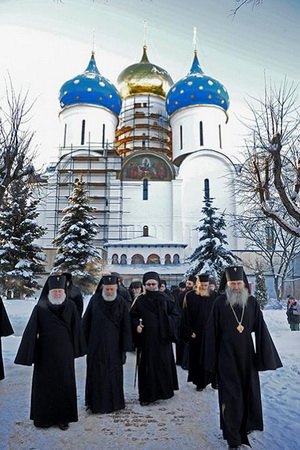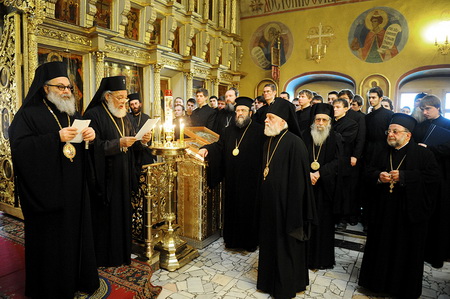A summary of some of the 4th day events- in the…
The irenic visit of His Beatitude Patriarch to the Patriarchate of Moscow and all Russia - a report about 4th day events- in the morning- Moscow.
At the 4th day of the Antiochian patriarchal visit to the Church of Russia, the Antiochian delegation, headed by Patriarch John X, accompanied by a large delegation from the Patriarchate of Moscow to the famous monastery of the Holy trinity, known as “Lavra of the Holy trinity- Saint Sergios” in the city of Serghiev Posad, 75 Km in the North-East of Moscow.
 This “Journey- Pilgrimage” made us, as an Antiochian delegation, get in the depth of the spiritual, monastic and ascetic heritage of the Russian Church step by step, where our feet stepped on a holy land that witnessed the effort of great Orthodox ascetics.
This “Journey- Pilgrimage” made us, as an Antiochian delegation, get in the depth of the spiritual, monastic and ascetic heritage of the Russian Church step by step, where our feet stepped on a holy land that witnessed the effort of great Orthodox ascetics.
Our eyes saw monuments, buildings, icons, liturgical vessels, manuscripts, books… etc. that tell about the orthodox history of Russia and its majesty.
Our ears listened to the performance of huge choirs, huge in the number, in their humbleness, and in their good chanting. They welcomed the patriarch and the ecclesiastical delegation coming with him. It felt as these voices that are chanting like angels, were brought to us from the history of the prayer on which was built this monastery for too many years.
This monastic society is considered to be one of the most famous, the bigger, and the most ancient monasteries of Russia. It holds the name of St. Sergio Radoszynski, who established the monastery at the middle of the 14th century and increased the monastic life in it and around it together with his followers, and whom the Russian Church commemorates this year 700 years of his birth, because of his historical role in protecting Russia.
The word ”Lavra” has a Greek origin, that means in monastic orthodox tradition “a monastic society in which monks live a monastic life according to a common system: half aghioritic, half ascetic. In the Russian tradition “Lavra” is accorded in order to honor a big monastery, with a big dignity in the history of the ecclesiastical and monastic life of the Russian Church.
This monastery has another value, as St. Sergio Radoszynski is the one who blessed the Prince Dimitry Donskoy on 1380 at the evening of his famous battle of “Kolikova” against the Tatars, which is considered to be the first victory for the Russians after 150 years of being ruled by the Tatars. The tale of this blessing is pained on the monastery’s walls. Also, in this monastery St. Sergio had a vision, in which he saw the Mother of God promising him that he would have too many followers as much as the birds of the sky that cannot be counted. This vision is painted as well the fresco of the mess hall, to which the superior father of the monastery accompanied us, where the Antiochian delegation had lunch with the Russian delegation.
Furthermore, this monastery has a special value, because the famous icon painter St. Andrei Rublev painted his well-known icon “the Holy trinity” there, and painted the wonderful fresco of the monastery’s cathedral that gives you a sense of sobriety and glory, raising you to a mixed world between the present and the past, in the presence of the saints.
When arriving to this monastery in the morning, there was the superior father receiving the patriarch and his delegation with a large number of monks with a solemn procession with hymns.
The Patriarch with the delegation stepped in toward the first internal church in the monastery where was waiting big number of monks.
The first prayer of thanksgiving was in Arabic and Russian, before the shrine of St. Sergio where his relics are still there till now. Afterwards, they visited the shrine of one of his disciples in another church, next to the first one. Later, they arrived to the holy cathedral, where was presented a big number of religious academy students, monks and visitors. A prayer of thanksgiving took place, chanting and greetings for the Antiochian visitor with the delegation.
 His Beatitude John held a speech where he talked about the continuing relation between holiness, prayer, contemplation, piety, monasticism and the growth of theological academic life. The Patriarch said: “We should consider how our Orthodox Christian theological and academic life gets its origins and gets irrigated, till now, by the well of holiness, and it gets stronger and fed from monasticism, so that the monuments of academic science get built based on a life of prayer, not merely on studying books”.
His Beatitude John held a speech where he talked about the continuing relation between holiness, prayer, contemplation, piety, monasticism and the growth of theological academic life. The Patriarch said: “We should consider how our Orthodox Christian theological and academic life gets its origins and gets irrigated, till now, by the well of holiness, and it gets stronger and fed from monasticism, so that the monuments of academic science get built based on a life of prayer, not merely on studying books”.
He emphasized on the need to combine between piety and research in order to acquire the theology of prayer, not only an academic theology. He said: “We are invited through our faculties of theology to combine between both. We are invited to combine between the piety of our ancestors, their simple faith and theological studies. We are invited to see our future through the experience of the past, and to see the past through the eyes of the future. Piety had a distinct role maintaining faith and delivering it to us either in Antioch or in Russia. On the other hand, theology have played a significant role supporting faith and strengthening it. Piety of our ancestors, as called by some, their jealousy is the factor that kept our Orthodoxy from generation to generation”.
Later on they had a look on the monastery’s museum which includes internal halls for the Russian patriarchs, their clothes, photos, liturgical objects that belong to them, a big collection of icons, ecclesiastical masterpieces and liturgical vessels.
Afterward, everyone headed to the great hall, where they had an agape in the honor of the delegation, followed by exchanging gifts, books and souvenirs.

2025-12-09
Patriarch JOHN X’s Address at…
2025-12-06
2025-12-04
Celebrating the Feast of Saint…
2025-12-01
Address of Patriarch JOHN X The…
2025-11-24
Delegation from the Hungarian…







